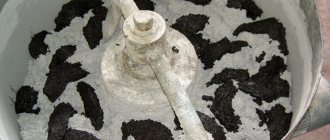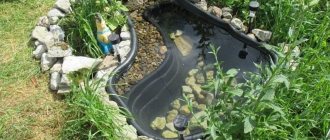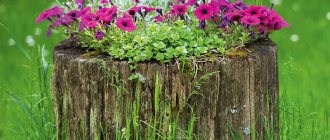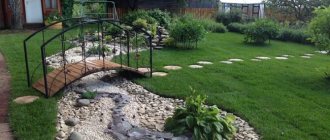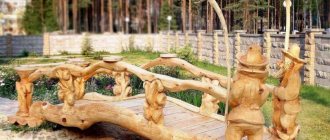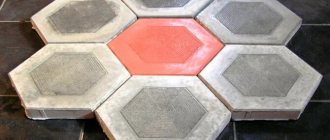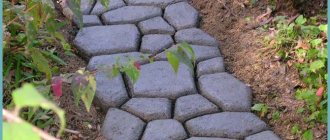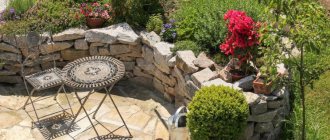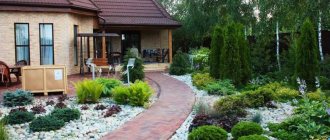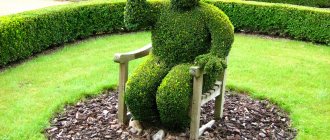Necessary materials
The set of additional tools and items largely depends on the complexity of the product. Making the vast majority of sculptures does not require special education, special skills or numerous expensive tools. However, for the successful implementation of the project, preliminary preparation is necessary. In order not to miss important details, you should adhere to the following plan:
- First of all, you need to decide on the project. The sketch should be selected taking into account the possibilities, since it is not recommended to begin your acquaintance with art by creating large scale figures. When thinking through a future project, it is important to take into account the features of the site and landscape, as well as the purpose of the future decoration. For example, small crafts in the shape of a mushroom, gnome or copies of small animals are perfect for children's playgrounds.
- Drawing up a sketch. In this case, it is not necessary to have artistic skills. If it is possible to draw the future sculpture as accurately as possible, this will be a great advantage. If there are no such skills, and relatives or friends cannot provide all possible help, a general craft scheme is quite suitable. This is necessary to calculate the dimensions and understand the procedure.
- Experienced craftsmen advise beginners to additionally create a 3D model of the sculpture in a reduced form. You can use a small piece of clay or plasticine as a material. This will not only allow you to better imagine the process of creating a concrete sculpture, but will also simplify your work. The smaller copy can be used as a sizing guide. Another tip is choosing a scale. Often a small workpiece turns out very beautiful and neat, but a full-scale model looks unsightly. To avoid such unpleasant consequences, you should use a ratio of 1:5 or a larger version.
- Before you begin to implement your plan, you need to prepare all the tools and auxiliary materials. A number of devices will be required. To prepare the mixture, you will have to use a large container and a concrete mixer. If you don’t have the latter, you can purchase a special attachment for a drill. But such a device is not suitable for mixing large volumes of cement.
- To prepare the mixture you need sand, water and a concrete plasticizer. Since the work is carried out outdoors, it is additionally worth using plastic film. Removing concrete stains from tiles or soil will not be easy.
- The tools you will need are spatulas of different sizes, a trowel and a spatula. This set is standard when working with concrete; the cost of the entrenching tool is low.
- Aluminum or steel wire may be required when producing voluminous and large sculptures. Concrete becomes strong only after complete drying and hardening. Working with a liquid mixture is not easy, so some techniques require the presence of auxiliary items.
- Pliers and wire cutters will help when working with wire when creating a frame. It is important to take into account the thickness of the material, since it is difficult to cut through very dense metal with a small tool.
- Some techniques for creating concrete sculptures make it possible to do without a frame. In such cases, special forms may be required. The method is simple, but finding a mold of the right size can be difficult.
- Paint and primer. After completing the main work, the most pleasant and exciting moment comes. The sculpture can be given its final look, using a primer to obtain an even layer, and paints of the desired colors for brightness and realism.
The list of preparatory work may seem long and costly in financial and time terms. But it is not so.
Most tools are standard, and it is impossible to do without them when working with cement. In addition, many items are always located in summer cottages.
Why are plaster sculptures needed?
Sculpture (high relief) of an Egyptian pharaoh, production and installation by Phoenix-Group, Moscow
Every property owner wants to decorate his country mansion or apartment, because it is more comfortable and relaxing for us to be in a cozy, beautifully decorated room. Some owners order stucco for the facade, landscape design project, and many choose plaster sculptures for use for the following purposes:
- Transformation of the facade of a country cottage. If you want to give your private home an unusual look, make it more aesthetically pleasing and memorable, then order sculptural works from the Phoenix-Group website for installation near the entrance. Fans of the classical style prefer to install figures of ancient gods and ancient Greek heroes, but for lovers of modern interiors we will offer suitable sculptures.
- Interior improvement. Sometimes it happens that even after a carefully thought-out renovation, it seems that something is missing. The space will sparkle with bright colors if you place plaster figures and handmade busts in different corners of the rooms.
- Decorating a personal plot or a small private garden. Creative architects with impressive work experience will prepare a project for a country cottage. Between the intricately winding paths and wicker gazebos there are garden sculptural compositions made of plaster. There is no need to worry about the safety of the statues - although this material is recognized as relatively fragile, after treatment with a chemical composition it will withstand exposure to moisture and temperature changes. Once prepared, garden sculptures will delight residents for decades.
We work with individuals and even legal entities - sculptural objects of art are ordered from us for decoration of offices, shopping centers and restaurants. Figures are often purchased by art schools and academies - there they become models for future artists and architects honing their skills. Masters specially make monuments realistic so that they can be used to learn to draw real people, maintaining proportions.
Our craftsmen make figures of different shapes and scales - both small and large. They can design an entire plaster composition, including various sculptures with a developed plot. Large customers are provided with favorable offers and a system of discounts. Contact the company's representatives to share your idea and find out the details of its implementation.
Production technologies
When choosing a model for a future sculpture, you should take into account not only the dimensions, design and aesthetic component, but also the complexity of production. Today, there are three main methods for making concrete sculptures:
- frame technology;
- pouring into ready-made molds;
- hand sculpting.

The latter technique has practically no nuances, and the work process can be compared to sculpting a model from clay or plasticine. The only condition is the consistency of the cement. The composition should not be too liquid so that modeling does not cause much trouble. This technique is suitable for creating only the simplest and smallest crafts. A good use would be to create many small figures that can decorate the facade of a house, potted flowers, or a garden plot with tiles.
Plaster sculptures - history
The history of sculptural compositions and individual busts made of plaster dates back to antiquity. For thousands of years, people have furnished their homes with fragments of decorative stucco - now archaeologists are finding bizarre statues inside Egyptian pyramids, ancient Roman, and ancient Greek buildings. The fashion for decorating space has not bypassed Russia either - plaster sculptures as parts of the interior appeared in the country back in the twelfth century. They served as decoration for the royal chambers and boyar estates.
The versatility of stucco decoration explains its popularity in modern times. Laconic compositions can embellish a building of any style - from classical (empire, baroque, rococo) to modern (high-tech, art deco). Entire sculptures and small busts emphasize the refined taste of the owner of the house, and also express his originality and creative approach. The designers of our stucco factory are ready to develop a unique project for your mansion or apartment, so that the space sparkles with bright colors and stands out from other rooms! We can decorate rooms in the same style or think about organic inclusions of classics in a modern interior.
Subtleties of the frame method
This technique is considered the most difficult. To create a sculpture, a preliminary wire structure is required, which will serve as the basis for the future product. The wire model does not have to repeat all structural elements. Its main purpose is to obtain a base, which will allow the sculptor to mold the frame into shape. There is no universal recipe for production. Any unnecessary things are suitable for the product: wood, rags, boxes. But it is best to create a base from aluminum or steel wire.
There are several ways to make a model. Medium or small sized figures can be made from aluminum wire. In this case, it is enough to use a regular binder, since the material is elastic. Steel wire will require a combined method. Some parts of the future frame can be tied together using pliers or another tool, other elements will have to be welded.
Most experts suggest making sculptures hollow. This option is considered preferable and has several advantages:
- Saving materials. A large sculpture will require pouring a decent amount of cement, and the material is not cheap.
- Ease. Do not forget that it may be necessary to move or move the statue. The weight of a cement-filled figure can be impressive.
- The hollow model is made using a construction mesh. The mesh frame is carefully and carefully covered with this material, after which the creation of a concrete sculpture is simple.
Apply cement to the frame using a spatula and trowel. Each new layer can be added after the previous one has dried. Movements should be light and neat. After completing the work, you should not wait for the concrete to dry completely.
When the solution has set, but has not completely hardened, it is important to correct all the shortcomings: eliminate unevenness and smudges.
Artistic processing of a plaster sculpture
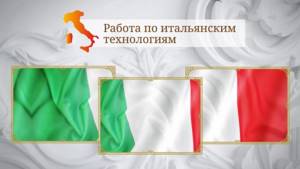
Statues for the home in a dazzling white shade will complement the classic decoration well, giving it originality and completeness. However, modern style does not involve decorating the space with stucco elements, but allows for the manifestation of imagination. Our designers have developed several ways of artistic processing of figures. These techniques will help you harmoniously fit decorative figures, busts, and monuments into a modern interior:
- Painting with bright colors. Only particularly resistant compounds - acrylic, water-based paints - can be applied to the surface of plaster. The bust can be completely multi-colored, leaving neon stains and bright spraying. Such an art object will complement the laconic interior.
- Coating with gilding or a solution that imitates the matte finish of bronze. Plaster statues can be brought closer in appearance to more expensive and refined materials - gold, bronze, porcelain, marble. For this purpose, the products are coated with special compounds.
- Applying varnish - the proven composition will reflect the dazzling rays of the sun, so the torso of the Greek hero will seem to glow in the sun. The varnish can have a silicone or polyurethane base; specialists will tell you about the differences between each brand.
The company's employees know exactly the patented technologies - entrust the decoration of the space to professionals. Order the production of monumental monuments, pedestals at the best prices - dial the number.
Pouring into ready-made molds
The success of implementing a planned project using the technology of pouring into molds depends on the preparation of the solution and the availability of the mold. The base can be purchased at the store or made yourself. Due to difficulties with assortment at points of sale, the latter option remains the preferred option. It is not necessary to perform complex elements in exact accordance with the dimensions of the future sculpture. Improvised means are quite suitable.
For example, a small and neat mushroom can be made using an old basin, a ball and a plastic bottle. The cap is obtained by pouring cement into a basin. The leg is even simpler: just pour the solution into a plastic bottle and cut the material after the material has hardened.
Some peculiarities exist in the technology of preparing concrete mortar. It is recommended to adhere to the following rules:
- The sand must be carefully sifted so that large particles of stones or other debris do not get into the future solution.
- Mix sand with cement in a ratio of 3:1, and when choosing between white and gray Portland cement, you should take into account the future color: paints on a white base look brighter. But the cost of the gray version is significantly lower.
- To the resulting solution you need to gradually add ordinary clean water and a plasticizer in an amount of 200 ml per 50 kg of cement.
- Mixing must be done very carefully. The finished mixture should have the consistency of thick sour cream.
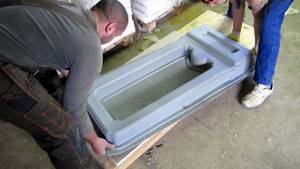
After completing all the work, you need to cover the sculpture with film and leave it to dry completely for 10-12 hours. Protection from rain and moisture will avoid unpleasant consequences if liquid gets on an unhardened base. After complete hardening, you can coat the product with a primer and paints of the desired colors.
What can plaster sculptures look like?
Phoenix-Group specialists are actively working to fill the catalog, trying to present all popular products. We regularly modernize our production so that the busts we produce are of higher quality. Designers also develop individual projects, reflecting through them the taste of the owner and the style of the entire living space.
You can decorate an office, a private house, or a spacious apartment by installing the following pieces of art:
- Figures – clients often order three-dimensional figures depicting Atlanteans, other mythological characters or animals. The production characteristics make it possible to produce both a full-fledged sculptural object with a relief visible from all sides, and a bas-relief with one protruding plane. If the scale of the room is large, the figure can be installed inside a specially prepared niche - this way it will look more original and attract attention.
- Busts - usually more compact works made in the form of the upper torso of famous historical figures (writers, composers), mythological characters. Such decorations will create the meaning of the interior or reflect the views and preferences of the owner of the building. Busts are produced with the faces of famous philosophers, musicians or poets, so the client is sure to find something suitable and close in spirit.
- Heads - if compared with a bust, which represents the shoulders and head of a person made of plaster, then only the character’s head will be a more laconic decorative option. Reduced variations are perfect for classic decoration and complement the space in Baroque, Rococo or Empire style.
- Pedestals - according to the manufacturing method, pedestals are similar to columns, but these decorative parts perform a supporting function, acting as a stand for a separate plaster figure or an entire composition. The pedestal can have a round or square base and is decorated with fancy stucco with floral motifs or geometric patterns. Visitors to the online stucco store phoenix-group.ru often order monumental bases for arranging large plants or flower pots.
By transforming your home with real objects of art, you will create a unique look for your cottage or apartment. Your guests will not be able to forget the design, decorated with stucco ornaments, sculptures, bas-reliefs or plaster figures.
Any design object made of plaster, the production of which took place in accordance with all requirements and standards, will be a good gift for a connoisseur of stucco decorations. Managers are ready to advise you on products in your preferred price range - we can also make an author’s portrait bust in a single edition. Your friends or loved ones will remember this gift for a long time.
Concrete fungus
A bright fly agaric, boletus or any other mushroom is created simply. There is no point in trying to get an exact copy of any mushroom model from concrete; you can achieve the desired similarity with the help of paints. For such a sculpture, it is best to use concrete, which in its state of aggregation should resemble melted butter. There are many step-by-step instructions, one of the options is the following set of actions:
- Using a deep bowl, make a depression in the sand;
- put a burdock leaf on the bottom to give it roughness;
- for the production of legs, a plastic bottle, rolled linoleum or roofing felt is perfect;
- after both parts have dried, fill the top of the leg with a new solution and connect the elements together;
- complete drying will require 2 days; during this period of time it is better to keep the figurine under film.
To create complete compositions, you can make several mushrooms of different sizes and place them on the base. Thus, real mushroom glades will appear on the site, which look very harmonious on the green lawn.
Use of leaves
Using burdock, mallow, rhubarb or other plants you can create amazing concrete pieces. The production process is simple. The solution is prepared by mixing 1 part Portland cement and 3 parts sand and water. The liquid must be added gradually, thoroughly kneading the mixture. The result should be a consistency similar to curd mass. It is worth pouring a small pile of sand on top and placing a whole leaf of the plant. All that remains is to fill the entire surface with cement mixture. After drying, a sheet with a magnificent relief shape separates. You can paint such details with any colors.
Using similar methods, you can obtain imitations of boulders, concrete balls and hemispherical figures. An important step is coloring. Thanks to a good combination of colors and careful work, the product acquires its final appearance and becomes a decoration for any area.
